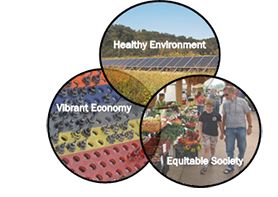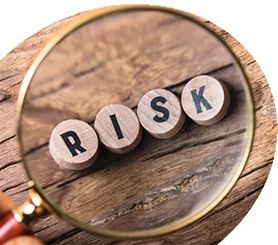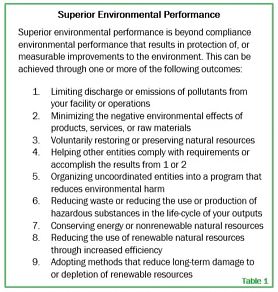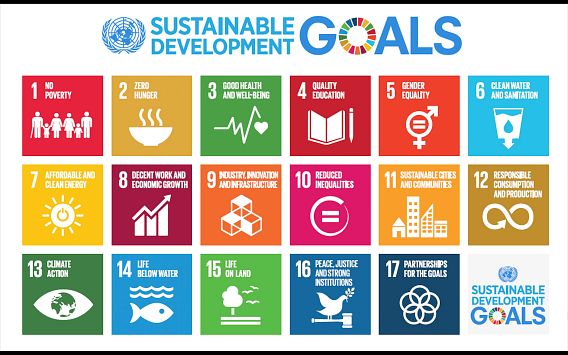Sustainability
Sustainability is generally used to describe ways in which we can provide for the needs of today without compromising the needs of the future. This is especially important to build prosperity for future generations when one considers the economic, environmental and social impacts that can arise from a changing climate.

In business terms, sustainability can be defined as managing your triple bottom line: people, planet and prosperity; or said another way: the financial, environmental and social opportunities of your business.
When working on projects that are focused on all three elements of sustainability, the co-benefits and long-lasting impacts often extend well beyond the individual project itself. Incorporating sustainability into daily decision-making can significantly improve the opportunities for your business, even if a project does not cross all three categories. Using sustainable thinking is what positions your business to be more efficient and resilient while creating a competitive advantage.
Keep reading for more information on the benefits you can experience on your path to sustainability, including how to:
- Meet stakeholders' needs and expectations
- Save money and give your business a competitive advantage
- Position your business for the future
We also include resources on how to accomplish this, like:
- Initial steps your organization can take to prioritize sustainability
- Join others with shared commitments
- Environmental Project Ideas
Meet Stakeholders' Needs and Expectations

With increased pressure from consumers, investors, stakeholders, and supply chains, coupled with increased competition in the market, many businesses like yours are being challenged to assess how their operations interact with the environment. Click on the headings below to learn more about the interests and value of working with your stakeholders on sustainability practices.
Consumers
Deloitte Insights reported that consumers are key to driving change in industries. Customers are purchasing green products and seeking out businesses that partake in more environmentally friendly and sustainable actionsi. Consumer surveys also find that more than two-thirds of Americans consider sustainability when making a purchase and some consumers have even demonstrated that they are willing to spend more money on a product if the producer has a track-record of environmental or social action.ii
Employees
Strong sustainability commitments by employers were shown to increase happiness, productivity, loyalty, retention and engagement rates for employees. The next generation of our workforce is seriously committed to working for companies that have a commitment to sustainability. In a study conducted by Edelman Intelligence, 56% of respondents even said that "ignoring sustainability in the workplace is as bad as ignoring diversity and inclusion.iii" Building the right culture for employees is about more than just employee satisfaction, it can also improve business performance. A similar study from Gallup found that businesses who foster high employee engagement rates increased profitability by 21% while maintaining low turnover rates and a healthy work environment.iv
Supply Chain
If your business is creating real outcomes for sustainability, it improves your chances to win contracts, find new opportunities and solidify reliable access to sustainably sourced raw materials. The push for companies to incorporate sustainability into their supply chains has significantly increased in recent years. Companies are looking both up and down their value for other organizations who share a strong commitment to the environmental and social aspects of their businessv. Giving preference to like-minded organizations will lead to a supply chain that is more stable and resilient to any disruptions resulting from climate change.
Investors and Lenders
Investors and lenders know that sustainability is more important than ever to develop successful portfolios. The Marsh & McLennan Global Risk Center reports that investors view climate change as a material investment risk. Investors recognize that incorporating sustainability into a corporate philosophy is a marker of long-term thinking, which creates resilient business practices that in turn, lower risk and make a company more investable.vi These stakeholders are increasingly looking to find businesses that demonstrate strong environmental ethics and can document tangible results as a way of preserving long-term value for their portfolios.
Save Money and Give Your Business A Competitive Advantage
When the environmental and social aspects of your business are incorporated into a strategic vision, you can create economic advantages for your business. Implementing sustainable practices into daily operations yields a competitive edge, but also expands the bottom line.
Investing in sustainability is investing in the future of your business. Initiatives with a focus on environmental impact reductions typically have a return on investment that is favorable for your business.vii Anthropocene Magazine reports that a majority of companies who have pursued sustainability have found that sustainability has been good for their bottom line.viii By pursuing initiatives that reduce consumption and improve your environmental footprint, you can save money and set yourself apart from the competition.
Often referred to as "low-hanging fruit," there are many short-term investments that can help businesses save money now, while also creating direct environmental improvements. Simple efforts to improve energy efficiency, upgrade equipment, improve processes, reduce consumption and find replacement materials, are just a few examples where you can find value in upgrading your operations. You may also consider assessing waste streams to find and stop the leakage of value from those areas.
Small actions can add up to a big impact, but it is also important to note that big actions pay dividends over time. Long-term initiatives can go beyond day-to-day improvements to achieve sustainability. You can position your business to be a leader in the marketplace by planning for ways to build a competitive advantage.
Long-term investments in sustainability can be used strategically to gain new customers, approach new markets, advance new technologies or even improve the quality of life for your community and employees. These types of investments may not have a traditional three-year return-on-investment, but they are critical to the long-term success of a business.ix
Implementing efforts like renewable energy, carbon-neutral commitments, zero-waste commitments, life cycle analysis and materiality studies are an investment in the business as much as they are an investment in sustainability. While the capital expenditure to achieve these goals may seem steep at first, the projects often yield a lasting return-on-investment, helping you save money, increase profitability, build resiliency and position your business for future success.

Environmental Management Systems, like ISO 14001, can be a great method to help identify short and long-term opportunities for cost savings that result from making incremental improvements to your environmental impacts. The focus on continual improvement helps you plan for future improvements while building on year-over-year returns from past projects. These systems provide an international standard to leverage aspects of your business to your advantage, identify risks and opportunities, and demonstrate leadership.
The environmental side can be easier to quantify than the social side of sustainability projects, but they are still an important piece of the puzzle. Social programs that focus on diversity, fair trade, fair payments and community involvement may not directly impact the bottom line, but they can impact the perception of your business by customers, supply chain and the public. As the consumer sustainability study found, building a good reputation can help with customer acquisition efforts and increase the bottom line, especially when you have a good reputation.x
A successful business can anticipate changes in the industry and be the first to act, finding a niche and solidifying its position in the market. Pause for a moment and look beyond the five-year plan. Where is your industry headed? What are the innovations leading the industry? How can you meet the market where it is going? There are big gains to be realized by planning for the future and investing in your business. If you can be the first company to achieve a new technology or incorporate sustainability in an unlikely place, you will likely find that you have taken the lead in your category.
Position Your Business for the Future
Managing risks is an important and daily task for business leaders to stay competitive. Wisconsin businesses understand that a changing climate poses a multitude of risks to their business, and they recognize opportunities to leverage significant benefits to their business.

Manage Risks
Environmental risk has been acknowledged in risk assessments since the 1970s. Companies know the importance of managing their environmental impacts to maintain compliance and minimize the penalties associated with falling out of compliance. It is a sound business practice to meet requirements and maintain a safe environment for people to live.
That traditional compliance-based approach is helpful for recognizing some of the significant environmental aspects and impacts of your business, but it is important to understand that environmental risks extend far beyond compliance. Shifting your focus to a broader, risk-management-based approach can help any organization take control over its future.
The Center for Climate and Energy Solutions categorizes environmental risk as either physical (asset damage, extreme storms, etc.) or transitional (social perceptions, customer decisions, regulatory changes, etc.).xi These challenges have always existed in some capacity, but as the global climate gradually changes and warms, the potential negative impact from these events has drastically increased and will affect many industries in Wisconsin.xii
It is time to recognize the need to adapt to both physical and transitional risks. Companies around the world are already facing disruptions, and while it is still important to consider the future risks of climate change, acting now can help prevent more severe impacts in the future.
Identify Opportunities
Where there is a risk, there is opportunity. Your organization can get ahead of the curve by proactively taking advantage of your opportunities and position your business to become a leader in the market. Your response to risk management is likely influenced by your industry, the innovative character of your company and the individual interests of your employees.
You should find the opportunities that best suit your business interests, but as Forbes suggests, any business can embed a sustainability philosophy into its strategic direction. Some of the first actions that you can take include:
- Incorporate environmental and climate risks into business decision-making.
- Set objectives and targets to make an incremental change based on environmental impacts.
- Manage existing and future environmental risks more effectively.
- Find opportunities to prevent additional environmental risks and benefit your business.xiii
So, how can a business position itself to be more resilient in the event of a disruption? There are several significant business risks associated with climate change, all of which offer unique opportunities to have a positive social and environmental impact. According to Morgan Stanley, businesses that seize these opportunities can bring important change to their sector.xiv
The list below provides a few examples of how environmental, social, and economic risks can affect businesses in Wisconsin and includes sustainability opportunities that can arise from such events.
Physical Risk Examples
Risk: Loss of biodiversity can lead to insufficient raw materials and have major effects on production, especially in energy production, forest production or the agricultural industries.
Opportunity: Biodiversity, environmental preservation, and restoration practices are unique opportunities to create environmental resiliency and help you to preserve resources in a way that you will be able to meet the future needs of your business.
Risk: Floods, fires, drought, heat and other environmental disasters can pose physical risks to human health and business assets, and in some cases, can cause extended shutdowns.
Opportunity: Investing in local environmental resiliency efforts can help mitigate extreme weather impacts on your business and community and avoid adverse climate impacts.
Risk: Extreme weather and climate disasters can destabilize resource availability and supply chains.
Opportunity: Substitute raw materials that are more environmentally friendly or identify a backup option to help relieve pressure in the event of a disruption. Focusing on supply chain resiliency allows your business to identify a more stable and resilient resource supply
Risk: Relying on outsourced energy production can disrupt your operations during a climate disaster.
Opportunity: Identify how your company can be more resistant to costly shutdowns or lag times caused by energy shortages. Renewable energy implementation and investment are great options to become more competitive and self-sufficient. Supplementing your energy production can be done by installing location-appropriate alternative energy systems on-site, which will keep you up and running when disruptions occur. Focus on Energy and Renew Wisconsin have great resources to help you identify and plan for the renewable energy project that is right for your business.
Transitional Risk Examples
Risk: Falling behind the market by keeping outdated or dirty practices.
Opportunity: Invest in low-carbon markets, new technologies, alternative supply chains, or even other businesses can help you get ahead of the curve and become a leader in your industry. Stay ahead of future regulations. Use scientific data to plan for capital investments based on trends, technology, and best management practices to adapt to predicted impacts in your location.
Risk: Insurance companies and lenders use sustainability performance indicators, like Environmental, Social, and Governance, when underwriting commercial policies and assessing loan applications. If sustainable approaches are not integrated into your company's practices, you may be in a higher risk category, ultimately costing you money.xv
Opportunity: Invest in projects that conserve resources, like water, air emissions, land use, raw natural inputs, and more. Showcase your environmental and social achievements through vehicles like an annual report demonstrates your progress and future commitments so lenders and insurance companies can easily see your accomplishments.
Risk: Consumers are driving demand for green products that are also manufactured with green operations. Your choices define your business reputation, and if consumer requests are ignored, can give an advantage to competitors.
Opportunity: Develop and maintain your reputation as a sustainable company to gain new customers and prospective employees. Evaluate your production processes as well as the product to lower its footprint through the life cycle of the product.
Risk: Unsuccessful recruitment or high turnover rates due to inadequate environmental or social policies and initiatives.
Opportunity: Clearly communicate environmental and sustainability policies to existing and prospective employees. Invest in your employees to help improve morale and retention rates which keep operations running smoothly and continuously.
Depending on your business, your sustainability initiatives can take many different forms, but at the core, they can help you address the risks posed by a changing climate and go a step further to seize the opportunities that arise from addressing the risks. This is not a problem for another day. Businesses that work on sustainability outcomes become more resilient in the process. These organizations will be most successful in mitigating risk factors and providing economic certainty as they contribute to a more sustainable future.
Initial Steps Your Organization Can Take to Prioritize Sustainability
Each year more and more consumers are purchasing green products, even seeking out industries and businesses that take sustainability seriously. Businesses are finding out that implementing sustainable practices into their organization not only gives their business a competitive edge, but also expands their bottom line. EPA's Smart Steps to Sustainability 2.0 is a great resource to help you get started. While it is targeted at small businesses, this guide can apply to businesses of any size.
Join others with Shared Commitments
Collaboration with other organizations can help propel you faster on your sustainability path and compound your shared environmental goals. By engaging with others, you can find innovative solutions that work for your business and improve your environmental footprint. There are countless ways to collaborate with others, whether it be with another business, a non-profit, or a governmental agency – you just need to find the right fit for your organization.
Green Tier and Superior environmental performance
Are you ready to lead the way and continue to advance your sustainability efforts? The Green Tier program is dedicated to helping you take your environmental performance to the next step. Through Green Tier, you can partner with the DNR to reduce your footprint and enhance your environmental improvement efforts.
Participating at the Tier 1 or Tier 2 level helps you to systematically manage your impacts through the implementation of an environmental management system while participating in a Charter offers unique opportunities for public and private entities to collaborate and achieve shared environmental goals.
By joining Green Tier, you join a group of environmental champions who are working to achieve their commitment to Superior Environmental Performance (Table 1). These nine outcomes define how environmental efforts will be recognized and position you to be a leader in your field.
Whether you choose to join the program or not, the outcomes resulting from Superior Environmental Performance will lead to direct environmental improvements in Wisconsin that reflect on your commitment to maintaining a sustainable business.
Be Part of the Global Solution
At an international level, the United Nations have established a call to action for sustainable development in the form of 17 clear goals for the future. The goals span across the spectrum of sustainability and are dedicated to ending poverty, protect the planet, and improve the lives and prosperity of everyone.
Over the past several years, these goals have been adopted by companies who are looking to make a difference in their communities and around the world. The 17 goals have become a universal measuring tool to determine how your business is implementing its' philosophy to create a better future.
Your organization can adopt any of these goals to establish the long-term vision for your organization. You may notice that you are already working on goals and projects that contribute to the implementation of the goals. For example, if you are working on achieving the Superior Environmental Performance outcomes described above, chances are that your accomplishments already align with several of these goals. Check out our crosswalk between Green Tier and the UN SDGs.
It is important to show how your existing and future efforts connect to the large-scale environmental, social and economic efforts. Aligning with large-scale efforts helps show your stakeholders that you are serious about contributing locally to help create a better future globally.
Reporting and Commitments
To be transparent and open with their efforts, many organizations choose to publish annual sustainability reports so that their stakeholders, investors, and employees can see the progress that is being made in the areas that are most important for the future of the company.
There are many different initiatives and commitments that can help drive your sustainability goals in a way that is standardized and measurable. The Global Reporting Initiative and the Carbon Disclosure Project are both well-known structures to help with disclosure efforts specifically related to sustainability and carbon footprints.
Corporate Social Responsibility reports and Environmental, Social, and Governance reports are both becoming common frameworks for communicating your story to interested parties. The Green Tier program also requires its participants to produce reports specific to their Wisconsin facilities, check out what Green Tier facilities are doing here.
If your company is also working to achieve strategic goals like going carbon neutral, implementing renewable energy, or pledging to produce zero waste, it is important to let your customers know your efforts! Consider looking into the available frameworks and share the story of your sustainability journey.
Environmental Project Ideas
With so many aspects to sustainability to work on, it can be hard to know where to start. We have compiled links to case studies, best management practices, articles and tools that will inspire ideas to help you continue your journey down the path toward sustainability. Check out this tool!
Resources
- Feeling the heat? Companies are under pressure on climate change and need to do more
- CGS Survey Reveals 'Sustainability' Is Driving Demand and Customer Loyalty
- HP Workforce Sustainability Survey Global Insights Report
- The Right Culture: Not Just About Employee Satisfaction
- 6 steps for a more sustainable supply chain
- How Climates Resilient is Your Company
- Sustainability innovations and firm competitiveness: A review
- A review of 100 studies crushes assumptions about conflict between profit and sustainability
- Sustainability and Return on Investment (Without the Spin)
- CGS Survey Reveals 'Sustainability' Is Driving Demand and Customer Loyalty
- Business Risks, Opportunities, and Leadership
- Climate Change Impacts in Wisconsin
- Climate Risk: What Businesses Should Do About It
- Risks and Opportunities of Climate Change



